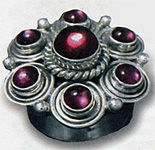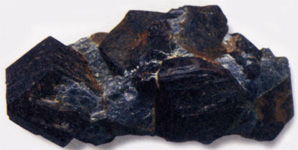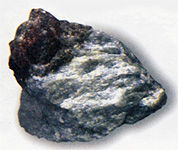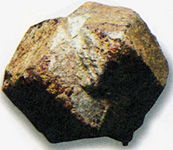Catalogue and magic properties of the stone -->rus
АЛЬМАНДИН
 Description characteristic of the mineral.
Description characteristic of the mineral.
Almandine garnet is the hardest and most widespread variety of red or red-violet pomegranates. A color of almandine can be cherry, raspberry, violet and even brown-red. Intensity of tint depends on the amount of connections of iron Fe. From almandine it is differed greater solidity only alike on them on colouring rubies. Rarely there are almost black almandine. The name of mineral is the distorted word of Alabanda - so a city was named in Asia Minor, where these stone were cut since olden times. On other version a township of Alabanda was only the trans-shipment point of ancient trade-routes. Jeweller stone are consider transparent almandine which can be cut only. Less valuable almandine are used in other decorations. The deposits of almandine exist in India, Mongolia, on Madagascar, in Finland and Karelia.
Almandine - most widespread jeweller Garnet. Clean almandine meet rarely, more frequent than all in them there is pyrope constituent. With pyrope and rhodolites almandine makes the so-called pyrope-almandine row of pomegranates. To distinguish from pyrope almandine at times is very difficultly, especially as they form an isomorphous row, the members of which have a gradual increase of values of closeness, solidity and indexes of refraction with growth of maintenance of Almandine garnet of constituent. In the middle this row there is rhodolite.
Excretions of almandine, as a rule, are much larger than grains of pyrope (not rareness crystals 4-5 sm) and better cut. Moreover, it often be found in the correct cutting. Good almandine not rareness in collections and decorations.
Colouring of almandine is related to the ions of bivalent iron Fe, at diminishing of concentration of which there is some weakening of color of stone, diminishing of his density. Almandine usually be found as well well-educated crystals - rhombic-dodecahedron, octahedron, often with shading on verges. Size of crystals from stakes there is to a few ten of centimetres, but the crystals of jeweller quality (suitable for cutting) are small are 5-6 mm. More large crystals are rare.
Sri Lanka is famous the best almandine. India and Brazil supply with good stone. There are almandine in the USA, Canada, Austria, Japan, Tanzania, Zambia and on Madagascar. In the CIS almandine are known yet from XVIII century on the Kolskiy (Kola) Peninsula, in Karelia, on Sonth Ural, in East Siberia. Most large mine deposits - Kitelskoe (ashore the Ladozhskoe lake, lake Ladoga) and Chupinskoe. Almandine, treated different appearance - verges, cabochon, polished, are used in jeweller wares; the most ancient form of cutting of jewels is widespread - as a patellula, it increases transparency of stone. The cost of almandine of good value and color is higher, than pyropes.
Magic properties of stone.
Together with garnet pyrope almandine are the stone of fire. Many people honoured almandine and added them magic properties is ability to drive away sorrow, bring gladness, heal heart and brain, to excite passion and at the same time to moderate anger. Indian yogis consider almandine a stone, possessing strong energy. It beneficially influences on the emotion of people. Not by chance in Europe almandine were considered the stone of balls and masquerades.





Poisonous and radioactive risky hazardous cargo stone and minerals
** - are poisonous stone and minerals (mandatory verification is in the chemical analysis laboratory + on toxicity)
** - are radioactive stone and minerals (mandatory verification on a regular dosimeter + prohibition on the opened sales in the case of radio-activity over 24 milliroentgens / hour + additional measures of protection of people)
All of rare stone are subject obligatory verification on a regular dosimeter on the possible level of radiation and in a chemical laboratory on absence default of poisonous and evaporating components, dangerous for a human people and environment nature
- Free download article Very dangerous and potentially dangerous stone and minerals are in Medical stone therapeutics, with pictures, 2010 year, format of PDF, 2.80 Mb (Presentation from scientific of author K.305 of pictures of very dangerous and potentially dangerous natural stone and minerals which on a bad motive or criminal indifference can be illegally used in criminal and "underground" "Medical stone therapeutics"). Rus langv.
A catalogue of stone is all of stone in alphabetical order
- Signs of travelling traffic lane markings - to transportation and marking of dangerous load Policy Rules
- Rules of Road Transportation of Especially Dangerous Loads, Hazardous cargo commodity, signs index plate
